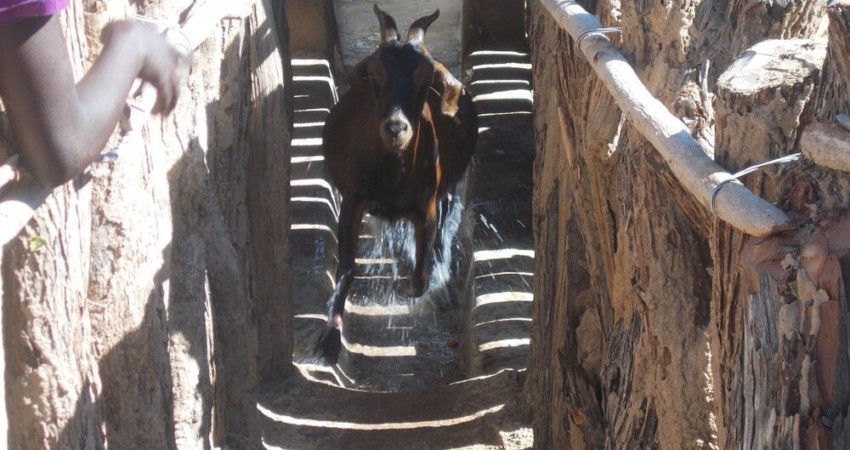

Plunge Dip Tanks
Plunge dip tanks are the preferred method of dipping large numbers, especially beef cattle. If constructed and used correctly plunge dips ensure complete wetting of the animal, particularly the important areas such as inside the ears and under the tail where ticks are found. Sheep and goats can be effectively dipped in a plunge dip but a handler must be ready to assist them when necessary. They may have to be physically thrown into the dip and prevented from turning around once in the dip tank.
Plunge dips must be correctly used and maintained to ensure adequate tick control
They are expensive to construct and to maintain. It is essential to keep accurate dipping and replenishment records; under strength dipping leads to inadequate tick control and tick resistance to acaricides. Evaporation and dilution by rain can cause inaccurate readings. Every animal, except very small animals and heavily pregnant animals must be dipped every dip day. Any animal not going through the plunge must be hand-sprayed or dressed.
Spray Race
The cattle spray race is a gentler method of dipping and more suitable for dairy cows, as there is less chance of injury. Dip is changed at every dip-day, unlike the plunge dip, so it is always at strength. However, correct maintenance and procedures must be followed to ensure adequate cover and effective tick control.
Nozzles must be correctly adjusted and regularly removed and cleaned to ensure even cover. Effective filtration to keep dipwash clean. The spray race must have the correct pressure. The dipwash must penetrate the animals coat without forming a mist. If pressure is too low, dipwash will not penetrate the coat effectively and will not go into the animals ears or under the tail.
It is virtually impossible to persuade sheep and goats to go through a spray race, although if they are used to running with the cattle, they may follow the cattle through!
Topical Treatments (Pour-ons)
Pour-ons are concentrated acaracides which are applied topically to the animals skin in small doses. They contain a spreading agent, usually oil-based, which allows the dip to spread over the skin of the animal. Pour-ons can be used on small numbers of animals or for a temporary measure but should not be relied on for complete tick control.
Most pour-ons are also effective against flies and midges and play a useful role in fly control programmes. Pour-ons are more expensive than plunge or spray dips. Animals must be dry when pour-ons are applied and may be ineffective if the animals are rained on shortly after treatment. Pour-ons can be used on goats and sheep without wool. They are not effective on woolly sheep, as they do not penetrate the wool.
Hand-spraying
Hand spraying is an effective method of tick control for a few animals who do not justify the expense of a spray race or plunge dip eg on small-scale commercial dairy farms.
Hand-spraying is a cheaper method of tick control than pour-ons. An effective knapsack sprayer must be used and the pressure set that the animal is wet thoroughly without the spray forming a mist. 7 – 9 litres of dipwash is required per head for cattle, less for sheep and goats.
Spraying should be against the grain of the hair to ensure wetting of the skin. Hand-spraying can be used for tick control in sheep and goats.
Hand Dressing
Hand dressing is the topical application of tick greases or oils to parts of the animal where ticks congregate, eg in the ears, under the tail-head. It should not be used as a complete method of tick control but can be used as a spot treatment between dip-days or in addition to any of the other methods of tick control. Tick greases and oils stick better to hairless skin and generally have a fairly long residual period.
Sheep and goats can be hand-dressed.
Belly Baths
Where tick infestation is mainly on the belly and legs of sheep and goats, a belly bath may be used. The head may need to be treated separately, either by spraying or hand-dressing. If the whole animal is to be immersed, a bath can be made with a 200 litre drum, but care must be taken to smooth of cut edges and it is physically demanding as the animals have to be man-handled into the bath. Only suitable for small numbers of animals.
 Contact Jaguza Support
Contact Jaguza Support